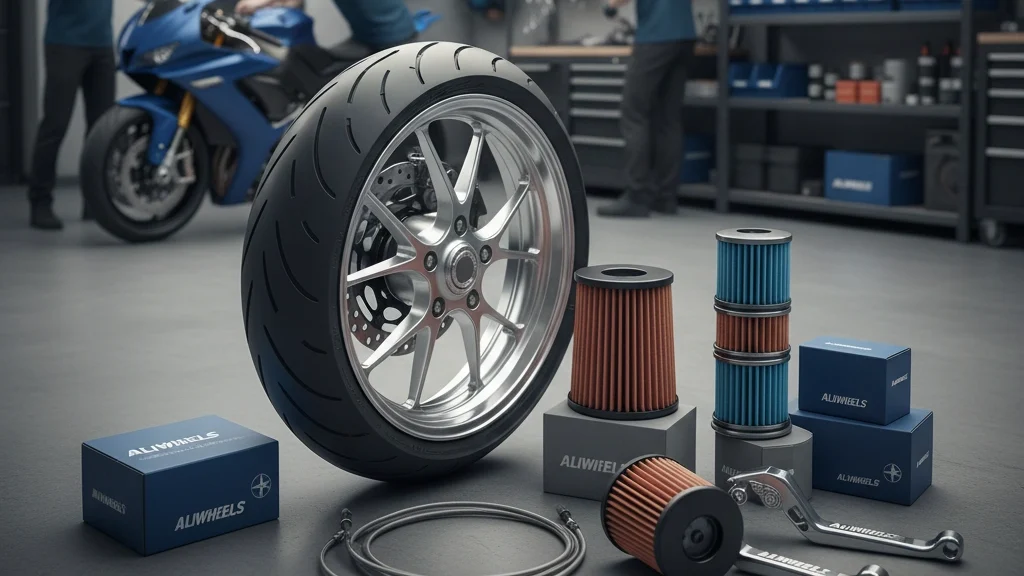New-bike thrill most motorcycle owners observe disappearing within a couple of months. A bike, which used to give instant response and quick power, turns slow and unresponsive. The offender is a silent loss of real performance in the drive train, which is slow wear on Chains and Sprockets that are usually not noticed by a rider until performance degradation becomes apparent. To Aliwheels delivery riders and anyone who commutes regularly, this issue is vital to know to maintain high satisfaction in riding and also the efficiency in operations.
Chain and Sprocket Wear
The connection between the engine power and the motion of the rear wheels is the chain and sprocket system. Any wear in these parts causes a series of issues that worsen riding:
- Unbalanced Power Swing: In a tired chain, rigid links will create jumpy acceleration.
- Premature Engine Strain: Driver tract compromises cause the engine to work harder, making it less efficient.
- Accelerated Component Wear: Broken sprockets exert additional strain on the entire transmission.
- Loss of Safety: A too old chain may skip or break.
Even the new bike can become a victim when they do not mind the chain maintenance. It is necessary to check the Chain and Sprocket Kit often to maintain that new bike feel.
Riders fail to consider this Element
There are several causes of neglect:
- Visual Deception: Chains will appear good, as they may conceal internal stretch and wear.
- Gradual Deterioration: Loss of performance is gradual; therefore, day-to-day may not be noticed by the riders.
- Maintenance Lies Transgressions: Most of them concern cosmetic care and disregard the mechanical maintenance.
- Technical Intimidation: Condition checking the condition of the drivetrain may appear frightening.
- Time Constraints: The hectic time means that maintenance would be delayed.
In the case of Aliwheels delivery riders, there is a collective of these factors with the operational pressures, and a storm occurs, which is damaging the efficiency and profitability of delivery.
Quality Chain and a Sprocket Kit can be Different
There are obvious advantages in investing in the high-quality Chain and Sprocket Kit and keeping it in good condition:
- Optimised Power Transmission: Accurate parts are extremely efficient.
- Improved Fuel Economy: Well-maintained drivetrain is capable of 8 percent fuel use.
- Long Component Life: Quality kits will make the related parts, such as the transmission gears, wear less.
- Better Safety: Safe chains get rid of the possibility of sudden failures.
- Regular Performance: A tidy, snappy drivetrain retains that new-bike sharpness.
One of the most cost-efficient methods to keep a motorcycle at its top is regular checkups and systematic replacement.
Drivetrain Health Step-by-Step Maintenance Procedure
A regular schedule maintains the drive train in good condition:
Weekly Inspection Protocol
1. Check the chain strain on the manufacturer’s specification
2. Check sprocket teeth, hooks or uneven wear
3. Look for stiff links or kinks
4. Check the correct positioning of tools

Cleaning and Lubrication
1. Wipe the chain using a specialist cleaner
2. Coat roller surfaces with a quality lubricant
3. Blot out the excess oil to stop the formation of dirt
4. Give time to penetrate the lubricant, then ride
Replacement Guidelines
1. Change when the stretch is beyond capacity
2. Change the whole Chain and Sprocket Kit as a balance
3. Apply the right equipment to adjust proper tension
4. Future dates of replacement of the records
Lack of Maintenance of the Chain and Sprocket System
- Progressive Loss of Performance: Riders become used to it and do not understand the reason
- Higher Operation Costs: Decreased fuel efficiency and faster wear
- Safety Concessions: Chains can either break under loads or acceleration
- High Repair Costs: Wear that is not taken care of may cause extensive damage
In the case of Aliwheels delivery professionals, these problems will translate to late deliveries, increased fuel expenses, and inefficient downtime, which has a direct impact on the stability of income.
Quick Tips for Busy Riders
Real-world plans assist in keeping the optimum driving gear in good condition within strict timeframes:
- Schedule Quick Checks: Visual checks at unofficial stops.
- Use Quality Products: Invest in a reliable Chain and Sprocket Kit replacement.
- Have Tools: A Simple tool kit to make tension adjustment.
- Track Maintenance: Basic applications or calendars will alert you about planned checks.
- Learn Basic Assessment: Educate folks on the signs of wear early so that they do not get out of hand.
Aliwheels riders can make these practices daily activities, like inspecting the chain prior to every shift and setting aside more extensive maintenance during slower times.
The Benefits of Maintenance to Riders
Adequate handling of the chain and the sprocket will possess practical professional benefits:
- Reliability of Delivery: Maintained bikes do not run out of shape in the middle of the work.
- Operational Efficiency: Streamlined drivetrains will ensure an enhanced economy and reduced running costs.
- Professional Reputation: Dependable performance generates customer confidence and increases platform credibility.
- Reduced Downtime Implications: Predictive maintenance saves time for repair.
- Long-Term Value: It means that a properly maintained bike will be highly resold.
When the maintenance is in the priorities of the riders, the Aliwheels ecosystem is strengthened, improving the satisfaction of customers and profits.
Conclusion
To a point, with accurate chain and sprocket maintenance, one can avoid gradual degradation, which makes a new bike feel old in a very short period of time. The identification of the significance of these parts and maintaining regular protection keeps the new bike alive in terms of responsiveness and efficiency. This emphasis is an excellent investment in the riding pleasure and business stability. A chain and Sprocket Kit is all that it takes to make sure that your motorcycle is prepared and ready to take you wherever you want to go, whether you need to go to work or take a ride on the weekend, for a fresh, efficient, and reliable experience.












